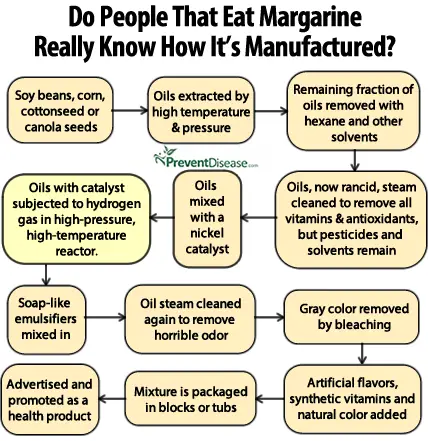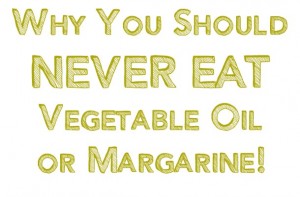By Natasha Longo
Polyunsaturated margarine became a major part of the Western diet and had overtaken butter in popularity in the mid-20th century. Despite their best efforts, the margarine lobby has failed to convince most people that their synthetic concoctions are healthy. So what is not obvious to most of the people who consume it? The manufacturing process of course, which is very similar to the way plastic is produced.
Did you know that numerous types of margarine carry the approved recommendations and seal of agencies that also promote cardiovascular health, such as heart and stroke foundations?
These days there are other con artists such as Earth’s Balance deceiving consumers and convincing perhaps millions of unsuspecting vegetarians and vegans into thinking they have the next best spread to replace butter when all they contain is genetically modified ingredients and more toxic oils like Canola.
[pro_ad_display_adzone id=”110028″]
Many consumers are also now choosing a particular imitation buttery spread because its label says it contains omega-3, not realizing the fatty acid is inferior compared with omega-3 from fish oil. For instance, Unilever Canada has been actively promoting the health aspects of margarine, particularly with its Becel line of products. Nearly all Becel products contains omega-3 derived from plant oils and usually through toxic extraction.
The problem is most consumers don’t have the nutrition savvy to know or understand how omega-3s are extracted and that they are not all the same.
Many of these spreads are only accentuating the all too pervasive imbalance that vegetable oils are causing with our omega-6 to omega-3 ratios. That imbalance has been linked to an increased risk for heart disease and may contribute to cancer, asthma, osteoporosis, inflammation, depression and other ailments. A growing body of evidence suggests the overconsumption of omega-6 needs attention.
Toxic GMO Soybean oil alone is now so ubiquitous in fast foods and processed foods that an astounding 20 percent of the calories in the American diet are estimated to come from this single source.
The ideal ratio between these two fatty acids is 1:1 and the nutritional habits of most people in developed nations has this ratio soaring more than 15:1 (omega 6: omega 3). So unless you are consuming reasonable amounts of omega 3 in your diet, you should stay away from any type of spread or oil saturated with omega 6. Omega-3 and omega-6 compete for the same metabolic enzymes. The dietary imbalance that exists in rice bran oil can create all sorts of problems to body processes, including a tendency towards inflammation.
Manufacturing Process

The basic method of making margarine today consists of emulsifying a blend of vegetable oils and fats, which can be modified using fractionation, interesterification, and/or hydrogenation of plant fats, chilling the mixture to solidify it and working it to improve the texture. Those fats that are liquid at room temperature are oils.
The oils are hydrogenated by passing hydrogen through the oil in the presence of a nickel catalyst. The addition of hydrogen effectively increases the melting point of the oil and thus “hardening” it. Margarines made in this way contain hydrogenated fat. If some of the chemical bonds aren’t hydrogenated during the process, they will still be present in the final margarine in molecules of trans fats the consumption of which has been shown to be a risk factor for cardiovascular disease.
To boost its health profile, modern margarines are making their products from wide variety of animal or vegetable fats, mixed with skim milk, and emulsifiers, such as soy lecithin to help disperse the water phase evenly throughout the oil, and preservatives are also commonly added.
The margarine industry has also taken to promoting the fact it’s low in saturated fat, a thinly veiled jab at butter. But growing evidence is now firmly establishing that saturated fat may not be a problem at all. A false interpretation of scientific studies has led to millions being “over-medicated” with statin drugs due to the proliferation of myths in the medical community regarding the role of saturated fat in heart disease.
Certainly if saturated fat was a problem, then coconut oil would be the unhealthiest oil on Earth, yet it’s the healthiest.
Actually butter contains many nutrients that protect us from heart disease. First among these is vitamin A which is needed for the health of the thyroid and adrenal glands, both of which play a role in maintaining the proper functioning of the heart and cardiovascular system. Abnormalities of the heart and larger blood vessels occur in babies born to vitamin A deficient mothers. Butter was and is still is recognized by many as the most easily absorbed source of vitamin A.
Butter contains lecithin, a substance that assists in the proper assimilation and metabolism of cholesterol and other fat constituents.
Butter also contains a number of anti-oxidants that protect against the kind of free radical damage that weakens the arteries. Vitamin A and vitamin E found in butter both play a strong anti-oxidant role. Butter is a very rich source of selenium, a vital anti-oxidant–containing more per gram than herring or wheat germ.
Why You Should Avoid Margarine, Shortening and Spreads
There are a myriad of unhealthy components to margarine and other butter imposters, including:
- Trans fats: These unnatural fats in margarine, shortenings and spreads are formed during the process of hydrogenation, which turns liquid vegetable oils into a solid fatTrans fats contribute to heart disease, cancer, bone problems, hormonal imbalance and skin disease; infertility, difficulties in pregnancy and problems with lactation; and low birth weight, growth problems and learning disabilities in children.A U.S. government panel of scientists determined that man-made trans fats are unsafe at any level. (Small amounts of natural trans fats occur in butter and other animal fats, but these are not harmful.)
- Free radicals: Free radicals and other toxic breakdown products are the result of high temperature industrial processing of vegetable oils. They contribute to numerous health problems, including cancer and heart disease.
- Synthetic vitamins: Synthetic vitamin A and other vitamins are added to margarine and spreads. These often have an opposite (and detrimental) effect compared to the natural vitamins in butter.
- Emulsifiers and preservatives: Numerous additives of questionable safety are added to margarines and spreads. Most vegetable shortening is stabilized with preservatives like BHT.
- Hexane and other solvents: Used in the extraction process, these industrial chemicals can have toxic effects.
- Bleach: The natural color of partially hydrogenated vegetable oil is grey so manufacturers bleach it to make it white. Yellow coloring is then added to margarine and spreads.
- Artificial flavors: These help mask the terrible taste and odor of partially hydrogenated oils, and provide a fake butter taste.
- Mono- and di-glycerides: These contain trans fats that manufacturers do not have to list on the label. They are used in high amounts in so-called “low-trans” spreads.
- Soy protein isolate: This highly processed powder is added to “low-trans” spreads to give them body. It can contribute to thyroid dysfunction, digestive disorders and many other health problems.
- Sterols: Often added to spreads to give them cholesterol-lowering qualities, these estrogen compounds can cause endocrine problems; in animals these sterols contribute to sexual inversion.
I don’t eat much butter myself but I would select it as an option on any opportunity over these chemical and so-called healthier spreads. If you really want to use a healthy spread, try coconut butter or one of many healthy nut or hemp butters available. The further you stay away from chemical and genetically modified spreads made with GMO oils, the healthier your diet will be.
Previous articles by Natasha:
- 8 Healthy Foods That Can Easily Replace Their Less Healthy Counterparts
- This Is What Happens In Your Stomach When You Consume Packaged Ramen Noodles With a Deadly Preservative
- Hemp Power Protein Smoothie Recipe
About the author:
Natasha Longo has a master’s degree in nutrition and is a certified fitness and nutritional counselor. She has consulted on public health policy and procurement in Canada, Australia, Spain, Ireland, England and Germany.
This article was reposted with permission from the kind crew at preventdisease.com
[pro_ad_display_adzone id=”110027″]







